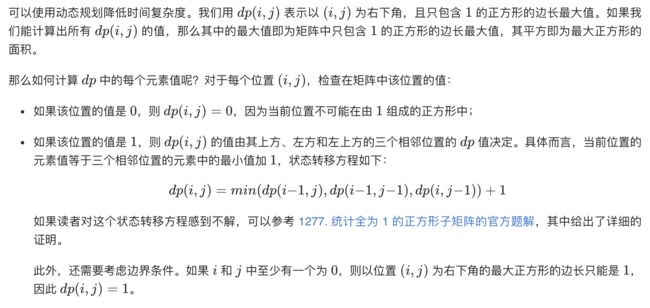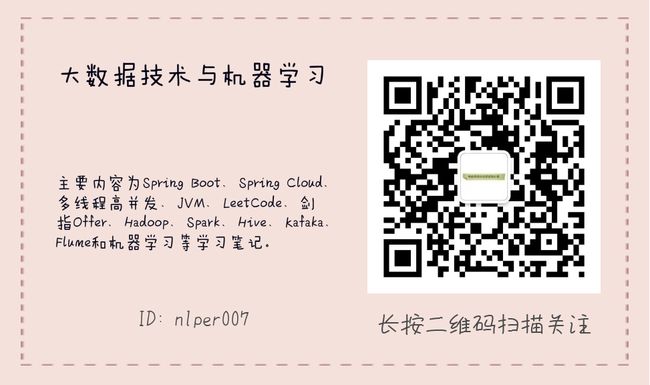LeetCode题解——随机刷题(二)
文章目录
-
- 114. 二叉树展开为链表
-
- 寻找前驱节点
- 221. 最大正方形
-
- 动态规划
- 301. 删除无效的括号
-
- 回溯算法
- 312. 戳气球
-
- 动态规划
- 399. 除法求值
-
- 并查集
-
- 推荐阅读
114. 二叉树展开为链表
114. 二叉树展开为链表
给定一个二叉树,原地将它展开为一个单链表。
例如,给定二叉树
1
/ \
2 5
/ \ \
3 4 6
将其展开为:
1
\
2
\
3
\
4
\
5
\
6
寻找前驱节点
/**
* Definition for a binary tree node.
* public class TreeNode {
* int val;
* TreeNode left;
* TreeNode right;
* TreeNode() {}
* TreeNode(int val) { this.val = val; }
* TreeNode(int val, TreeNode left, TreeNode right) {
* this.val = val;
* this.left = left;
* this.right = right;
* }
* }
*/
class Solution {
public void flatten(TreeNode root) {
TreeNode cur = root;
while (cur != null) {
if (cur.left != null) {
TreeNode next = cur.left;
TreeNode preNode = next;
while (preNode.right != null) {
preNode = preNode.right;
}
preNode.right = cur.right;
cur.left = null;
cur.right = next;
}
cur = cur.right;
}
}
}
221. 最大正方形
221. 最大正方形
在一个由 0 和 1 组成的二维矩阵内,找到只包含 1 的最大正方形,并返回其面积。
示例:
输入:
1 0 1 0 0
1 0 1 1 1
1 1 1 1 1
1 0 0 1 0
输出: 4
动态规划
class Solution {
public int maximalSquare(char[][] matrix) {
int maxSide = 0;
if (matrix == null || matrix.length == 0 || matrix[0].length == 0) {
return 0;
}
int rows = matrix.length, columns = matrix[0].length;
int[][] dp = new int[rows][columns];
for (int i = 0; i < rows; i++) {
for (int j = 0; j < columns; j++) {
if (matrix[i][j] == '1') {
if (i == 0 || j == 0) {
dp[i][j] = 1;
} else {
dp[i][j] = Math.min(dp[i - 1][j], Math.min(dp[i][j - 1], dp[i - 1][j - 1])) + 1;
}
maxSide = Math.max(maxSide, dp[i][j]);
}
}
}
return maxSide * maxSide;
}
}
301. 删除无效的括号
301. 删除无效的括号
删除最小数量的无效括号,使得输入的字符串有效,返回所有可能的结果。
说明: 输入可能包含了除 ( 和 ) 以外的字符。
示例 1:
输入: "()())()"
输出: ["()()()", "(())()"]
示例 2:
输入: "(a)())()"
输出: ["(a)()()", "(a())()"]
示例 3:
输入: ")("
输出: [""]
回溯算法
class Solution {
Set<String> set = new HashSet<>();
int maxLen = 0;
public List<String> removeInvalidParentheses(String s) {
int rmLeft = 0, rmRight = 0;
// 1、对于括号,有选和不选两种情况;对于字母,必须选
// 2、用计数器维护字符串状态,"("则加一,")"则减一
// 3、set去重
// 4、提前计算应当删除的左括号或者右括号的数量,用于剪枝
for (int i = 0; i < s.length(); i++) {
if (s.charAt(i) == '(') {
rmLeft++;
} else if (s.charAt(i) == ')'){
if (rmLeft > 0) {
rmLeft--;
} else {
rmRight++;
}
}
}
helper(s, 0, 0, new StringBuilder(), rmLeft, rmRight);
return new ArrayList<>(set);
}
private void helper(String s, int idx, int count, StringBuilder path, int rmLeft, int rmRight) {
if (count < 0 || rmLeft < 0 || rmRight < 0) {
return;
}
if (idx == s.length()) {
if (count == 0 && rmLeft == 0 && rmRight == 0) {
if (path.length() >= maxLen) {
maxLen = path.length();
set.add(path.toString());
}
}
return;
}
// 添加当前字符到path中
char c = s.charAt(idx);
path.append(c);
if (c == '(') {
helper(s, idx + 1, count + 1, path, rmLeft, rmRight);
} else if (c == ')') {
helper(s, idx + 1, count - 1, path, rmLeft, rmRight);
} else {
helper(s, idx + 1, count, path, rmLeft, rmRight);
}
// 不添加当前字符到path中
path.deleteCharAt(path.length() - 1);
if (c == '(') {
helper(s, idx + 1, count, path, rmLeft - 1, rmRight);
} else if (c == ')') {
helper(s, idx + 1, count, path, rmLeft, rmRight - 1);
}
}
}
312. 戳气球
312. 戳气球
有 n 个气球,编号为0 到 n-1,每个气球上都标有一个数字,这些数字存在数组 nums 中。
现在要求你戳破所有的气球。如果你戳破气球 i ,就可以获得 nums[left] * nums[i] * nums[right] 个硬币。 这里的 left 和 right 代表和 i 相邻的两个气球的序号。注意当你戳破了气球 i 后,气球 left 和气球 right 就变成了相邻的气球。
求所能获得硬币的最大数量。
说明:
你可以假设 nums[-1] = nums[n] = 1,但注意它们不是真实存在的所以并不能被戳破。
0 ≤ n ≤ 500, 0 ≤ nums[i] ≤ 100
示例:
输入: [3,1,5,8]
输出: 167
解释: nums = [3,1,5,8] --> [3,5,8] --> [3,8] --> [8] --> []
coins = 3*1*5 + 3*5*8 + 1*3*8 + 1*8*1 = 167
动态规划
class Solution {
public int maxCoins(int[] nums) {
int n = nums.length;
int[][] res = new int[n + 2][n + 2];
int[] val = new int[n + 2];
val[0] = val[n + 1] = 1;
for (int i = 1; i <= n; i++) {
val[i] = nums[i - 1];
}
for (int i = n - 1; i >= 0; i--) {
for (int j = i + 1; j <= n + 1; j++) {
for (int k = i + 1; k < j; k++) {
int sum = val[i] * val[k] * val[j];
sum += res[i][k] + res[k][j];
res[i][j] = Math.max(res[i][j], sum);
}
}
}
return res[0][n + 1];
}
}
399. 除法求值
399. 除法求值
给出方程式 A / B = k, 其中 A 和 B 均为用字符串表示的变量, k 是一个浮点型数字。根据已知方程式求解问题,并返回计算结果。如果结果不存在,则返回 -1.0。
示例 :
给定 a / b = 2.0, b / c = 3.0
问题: a / c = ?, b / a = ?, a / e = ?, a / a = ?, x / x = ?
返回 [6.0, 0.5, -1.0, 1.0, -1.0 ]
输入为: vector> equations, vector& values, vector> queries(方程式,方程式结果,问题方程式), 其中 equations.size() == values.size(),即方程式的长度与方程式结果长度相等(程式与结果一一对应),并且结果值均为正数。以上为方程式的描述。 返回vector类型。
基于上述例子,输入如下:
equations(方程式) = [ ["a", "b"], ["b", "c"] ],
values(方程式结果) = [2.0, 3.0],
queries(问题方程式) = [ ["a", "c"], ["b", "a"], ["a", "e"], ["a", "a"], ["x", "x"] ].
输入总是有效的。你可以假设除法运算中不会出现除数为0的情况,且不存在任何矛盾的结果。
并查集
详解见leetcode
class Solution {
private Map<String, String> parents = new HashMap<>();
private Map<String, Double> values = new HashMap<>();
public double[] calcEquation(List<List<String>> equations, double[] values, List<List<String>> queries) {
for (int i = 0; i < equations.size(); i++) {
union(equations.get(i).get(0), equations.get(i).get(1), values[i]);
}
double[] result = new double[queries.size()];
for (int i = 0; i < queries.size(); i++) {
String e = queries.get(i).get(0);
String q = queries.get(i).get(1);
if (!(parents.containsKey(e) && parents.containsKey(q))) {
result[i] = -1;
continue;
}
if (e.equals(q)) {
result[i] = 1;
continue;
}
String r1 = root(e);
String r2 = root(q);
if (!r1.equals(r2)) {
result[i] = -1;
continue;
}
result[i] = pm(q) / pm(e);
}
return result;
}
private void union(String parent, String child, double value) {
add(parent);
add(child);
String r1 = root(parent);
String r2 = root(child);
if (!r1.equals(r2)) {
parents.put(r2, r1);
values.put(r2, value * (pm(parent) / pm(child)));
}
}
private void add(String x) {
if (!parents.containsKey(x)) {
parents.put(x, x);
values.put(x, 1.0);
}
}
private String root(String x) {
while (!parents.get(x).equals(x)) {
x = parents.get(x);
}
return x;
}
private double pm(String x) {
double v = 1;
while (!parents.get(x).equals(x)) {
v *= values.get(x);
x = parents.get(x);
}
return v;
}
}
推荐阅读
- 剑指offer精品题解
- 机器学习资料汇总
- 吴恩达《机器学习》视频、作业、源码
- 106页《Python进阶》中文版正式发布
- 李航《统计学习方法》第二版完整课件
- 机器学习数学全书,1900页PDF下载


